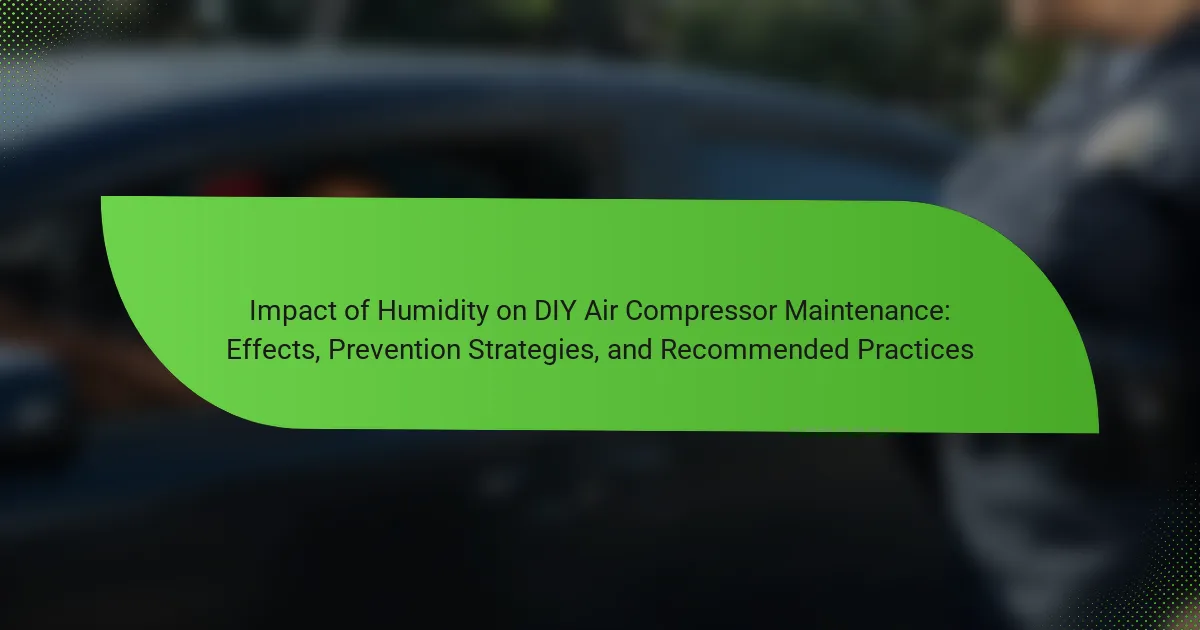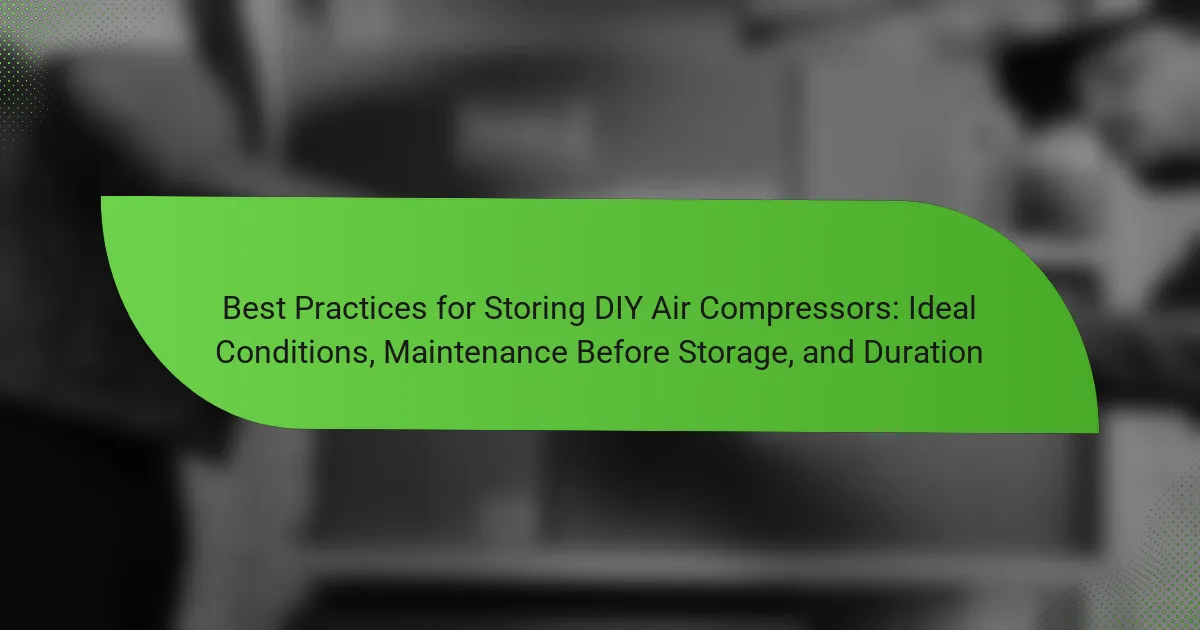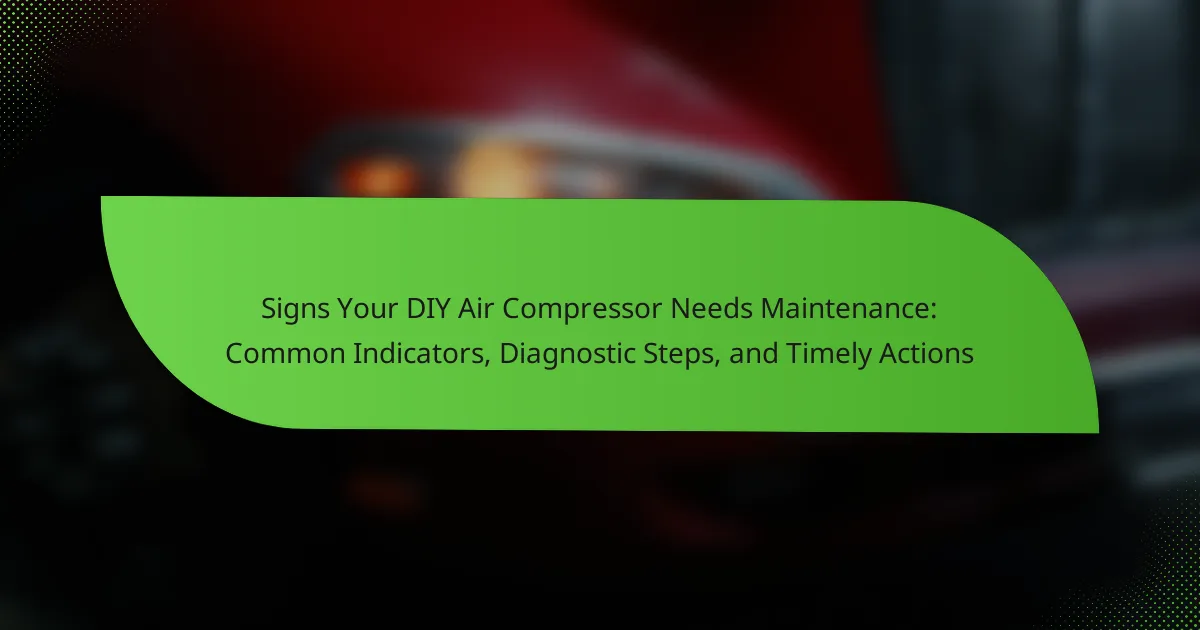DIY air compressors often face common maintenance issues such as oil leaks, air leaks, and clogged filters, which can hinder their performance. Key symptoms include overheating due to insufficient lubrication and reduced efficiency from blocked airflow. Effective troubleshooting techniques involve checking for leaks, inspecting the power supply, and examining the pressure switch to ensure proper operation. Regular maintenance practices, such as cleaning or replacing air filters and monitoring oil levels, are essential for sustaining optimal performance. Solutions for addressing these issues include replacing worn-out parts, ensuring proper lubrication, and maintaining adequate ventilation to prevent overheating.
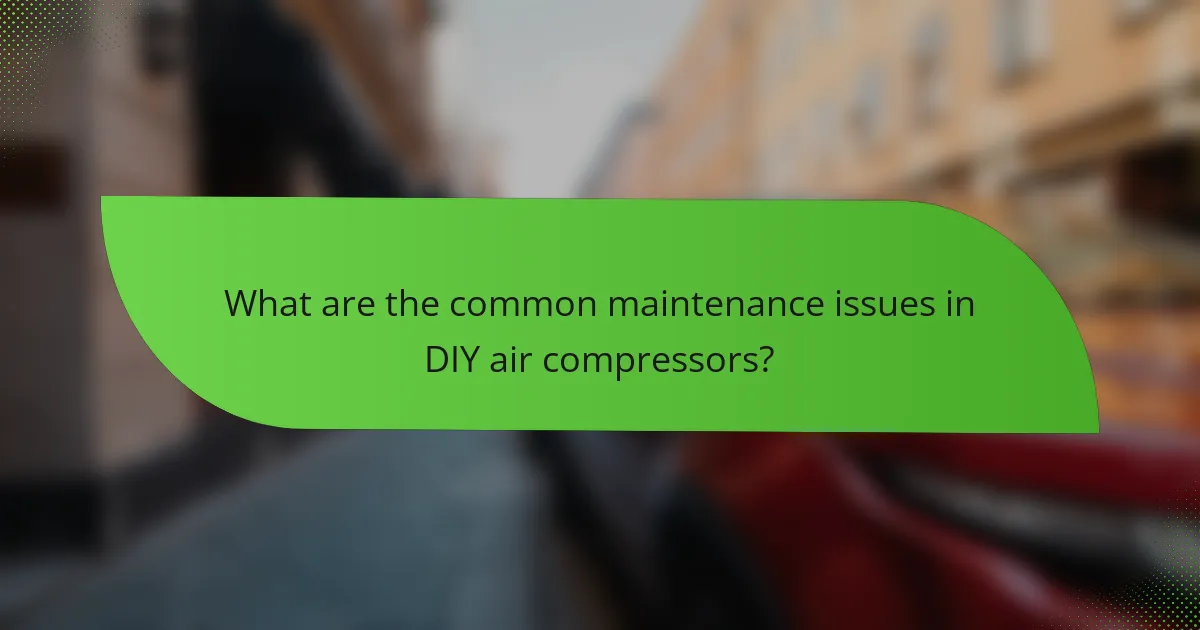
What are the common maintenance issues in DIY air compressors?
Common maintenance issues in DIY air compressors include oil leaks, air leaks, and clogged filters. Oil leaks often occur due to worn seals or loose fittings. Air leaks can happen at connections or through damaged hoses. Clogged filters reduce airflow and efficiency. Additionally, overheating can result from insufficient lubrication or blocked cooling vents. Regular inspection and maintenance can prevent these issues. Proper care ensures optimal performance and longevity of the compressor.
How can you identify symptoms of air compressor problems?
Identifying symptoms of air compressor problems involves observing specific signs. Common symptoms include unusual noises, such as knocking or hissing sounds. These noises often indicate mechanical issues or air leaks. Additionally, if the compressor does not start or frequently shuts off, it may signify electrical problems or overheating. Another symptom is a decrease in pressure output, which can point to worn components or blockages. Visible oil leaks around the unit are also a clear indicator of malfunction. Lastly, if the compressor vibrates excessively, it may suggest misalignment or internal damage. Monitoring these symptoms can help in diagnosing air compressor issues effectively.
What unusual noises indicate issues in DIY air compressors?
Unusual noises in DIY air compressors can indicate several issues. A hissing sound may suggest a leak in the air system. A loud banging noise often points to loose or damaged components. A high-pitched squeal can indicate a problem with the motor or belt. A continuous buzzing noise might suggest electrical issues or a malfunctioning pressure switch. These noises are critical indicators of underlying problems that should be addressed promptly to prevent further damage.
How can you recognize leaks in your air compressor system?
You can recognize leaks in your air compressor system by listening for hissing sounds, observing condensation, and checking for pressure drops. Hissing noises indicate escaping air, which often points to a leak. Condensation around fittings or hoses can signal moisture accumulation due to air loss. Additionally, if the pressure gauge fluctuates or drops unexpectedly, it suggests a leak in the system. Regularly inspecting connections and fittings for wear or damage can help identify potential leak sources. Using soap and water to create bubbles around suspected areas is an effective method to confirm leaks.
What signs suggest that the air compressor is overheating?
Signs that suggest an air compressor is overheating include excessive heat from the motor and casing. The compressor may also produce unusual noises, such as loud grinding or knocking sounds. Additionally, there may be a decrease in performance, such as reduced air pressure output. The thermal overload protection may activate, shutting down the unit to prevent damage. Visible signs like steam or smoke can indicate overheating as well. Finally, a burning smell may emanate from the compressor, signaling potential overheating issues.
Why is regular maintenance important for DIY air compressors?
Regular maintenance is important for DIY air compressors to ensure optimal performance and longevity. It helps prevent breakdowns and costly repairs. Routine checks can identify wear and tear before they escalate. Regularly changing the oil and filters maintains efficiency. Cleaning air intake filters prevents dust accumulation and improves airflow. Inspecting hoses and connections avoids leaks that reduce pressure. Maintaining the compressor also enhances safety by reducing the risk of malfunction. Regular maintenance can extend the lifespan of the compressor significantly, often doubling its operational life.
How does maintenance affect the lifespan of an air compressor?
Regular maintenance significantly extends the lifespan of an air compressor. Proper upkeep prevents wear and tear on critical components. Routine tasks include checking and replacing oil, cleaning filters, and inspecting hoses. Neglecting maintenance can lead to overheating and breakdowns. For instance, compressors that are not lubricated properly may fail within a few hundred hours of operation. In contrast, well-maintained compressors can last over 10,000 hours. Scheduled maintenance also improves efficiency, reducing energy consumption. This efficiency can save both time and costs in the long run. Therefore, consistent maintenance is crucial for maximizing the operational life of an air compressor.
What are the cost implications of neglecting maintenance?
Neglecting maintenance on air compressors can lead to significant cost implications. Immediate costs include increased energy consumption due to inefficient operation. Over time, this inefficiency can lead to higher utility bills, often by 20% or more. Additionally, neglecting maintenance can result in more frequent breakdowns. Each breakdown may require costly repairs or even complete replacement of parts.
Long-term neglect can also shorten the lifespan of the compressor. A well-maintained air compressor typically lasts 10 to 15 years, while a neglected unit may fail within 5 to 7 years. The cost of replacing a compressor can exceed thousands of dollars. Furthermore, downtime during repairs can lead to lost productivity and revenue. In industries relying on air compressors, this loss can amount to hundreds of dollars per hour.
In summary, neglecting maintenance not only incurs immediate costs but also leads to long-term financial burdens.
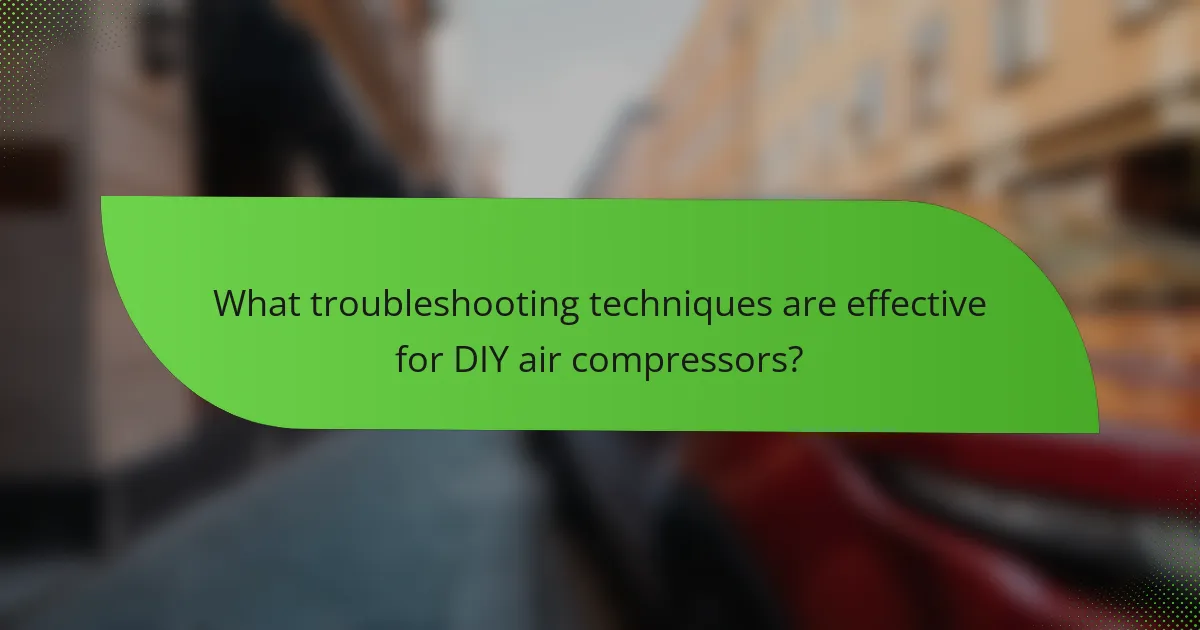
What troubleshooting techniques are effective for DIY air compressors?
Effective troubleshooting techniques for DIY air compressors include checking for leaks, inspecting the power supply, and examining the pressure switch. First, identify any air leaks in hoses or connections. Leaks can significantly reduce performance. Next, ensure the power supply is functioning properly. Verify that the compressor is plugged in and the circuit breaker is not tripped. Additionally, inspect the pressure switch for proper operation. A faulty pressure switch can prevent the compressor from starting.
Regular maintenance also plays a crucial role. Clean or replace air filters periodically to maintain airflow. Check the oil level in oil-lubricated models. Low oil levels can cause overheating. Lastly, monitor the compressor’s temperature during operation. Overheating can indicate a need for further inspection or repair. These techniques help maintain efficient operation and extend the lifespan of DIY air compressors.
How do you approach troubleshooting common air compressor issues?
To troubleshoot common air compressor issues, start by identifying the symptoms. Check for air leaks, unusual noises, or failure to start. Inspect the power supply and ensure the compressor is plugged in and receiving electricity. Examine the pressure switch for proper operation and settings. Verify that the air filter is clean and not obstructed. Look for any visible damage or wear on hoses and fittings. Test the safety valve to ensure it releases air when necessary. Regular maintenance, such as oil changes and filter replacements, can prevent many issues. Following these steps can help diagnose and resolve common air compressor problems effectively.
What step-by-step methods can help diagnose air compressor problems?
To diagnose air compressor problems, follow these step-by-step methods. First, check the power supply. Ensure the compressor is plugged in and the circuit breaker is not tripped. Next, inspect the pressure switch. A faulty switch can prevent the compressor from starting. Then, examine the air filter. A clogged filter restricts airflow and can cause overheating. After that, check the oil level. Low oil can lead to inadequate lubrication and damage.
Proceed to listen for unusual noises. Strange sounds may indicate mechanical issues. Additionally, monitor the pressure gauge. Inconsistent pressure readings can signal leaks or component failure. Finally, look for visible leaks. Inspect hoses and connections for air leaks. Each of these steps helps identify specific issues affecting air compressor performance.
How can you use pressure gauges to troubleshoot compressor issues?
You can use pressure gauges to troubleshoot compressor issues by measuring the pressure at various points in the system. This helps identify blockages, leaks, or mechanical failures. Start by checking the inlet pressure gauge. A low reading indicates a possible blockage in the intake line. Next, examine the discharge pressure gauge. A low discharge pressure may suggest issues with the compressor itself or valve problems. Monitor the pressure during operation. Fluctuations can indicate leaks or inconsistent performance. Additionally, compare readings against manufacturer specifications. Deviations from these values can pinpoint specific issues. Regular use of pressure gauges can enhance preventive maintenance and prolong compressor life.
What tools are essential for troubleshooting DIY air compressors?
Essential tools for troubleshooting DIY air compressors include a multimeter, pressure gauge, and wrenches. A multimeter tests electrical components for continuity and voltage. This tool helps identify electrical issues in the compressor’s motor or wiring. A pressure gauge measures the air pressure within the tank. This helps determine if the compressor is reaching the required pressure levels. Wrenches are necessary for tightening or loosening fittings and connections. Properly secured connections prevent air leaks, which can hinder performance. Additionally, an air filter cleaner helps maintain airflow and efficiency. Regular maintenance with these tools ensures optimal operation and longevity of the air compressor.
Which diagnostic tools should every DIY air compressor owner have?
Every DIY air compressor owner should have a pressure gauge, a multimeter, and an air leak detector. A pressure gauge measures the air pressure in the tank and lines. This helps ensure optimal performance and safety. A multimeter checks electrical components for continuity and voltage issues. This tool is essential for diagnosing electrical problems. An air leak detector identifies leaks in hoses and fittings. Detecting leaks can prevent energy loss and improve efficiency. These tools enable effective troubleshooting and maintenance of air compressors.
How can basic tools assist in troubleshooting air compressor problems?
Basic tools assist in troubleshooting air compressor problems by enabling users to diagnose and fix issues effectively. Tools like wrenches, screwdrivers, and multimeters help check for loose connections and electrical faults. A wrench can tighten fittings to prevent air leaks, a common issue. Screwdrivers allow access to internal components for inspection. Multimeters measure voltage and continuity, identifying electrical problems. Pressure gauges assess the compressor’s output pressure. Each tool plays a crucial role in identifying specific problems, leading to efficient repairs. Regular use of these tools can enhance the longevity and performance of air compressors.
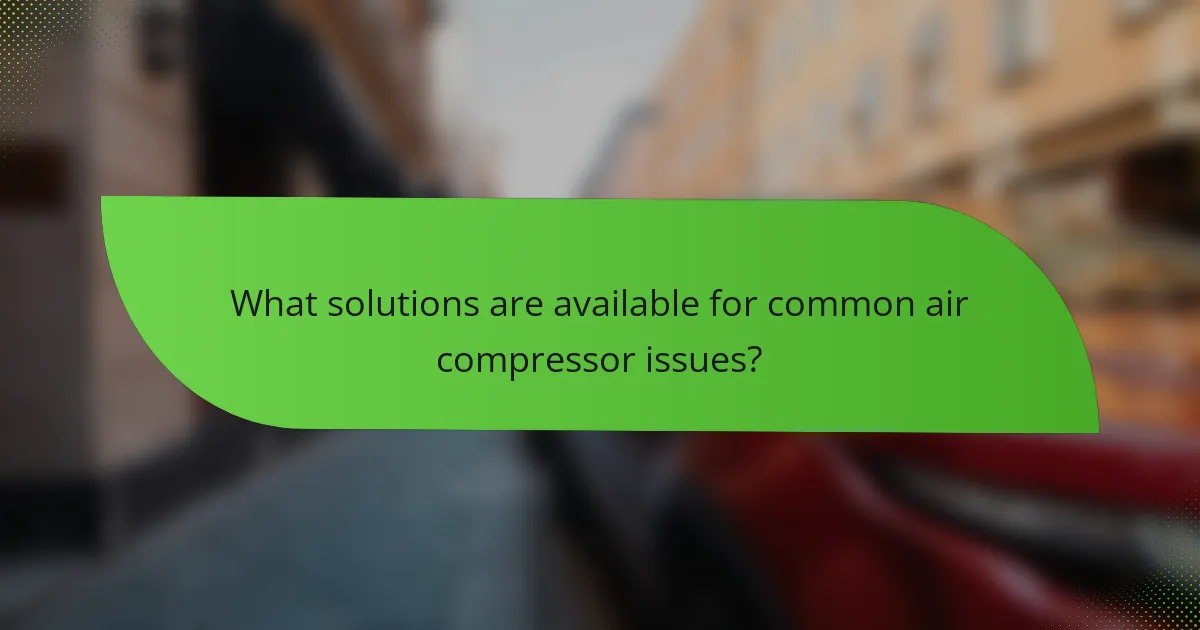
What solutions are available for common air compressor issues?
Solutions for common air compressor issues include checking and replacing worn-out parts, ensuring proper lubrication, and addressing air leaks. For inadequate pressure, inspect the pressure switch and adjust it if necessary. If the compressor is not starting, examine the power supply and reset the circuit breaker. For excessive noise, check for loose components and tighten them. Regularly clean the air filter to maintain airflow and efficiency. If overheating occurs, ensure the compressor is not overloaded and has adequate ventilation. These solutions can help maintain optimal performance and extend the lifespan of the air compressor.
How can you fix air leaks in your DIY air compressor?
Identify the source of the air leak in your DIY air compressor. Inspect all connections, hoses, and fittings for visible damage or wear. Tighten loose connections using appropriate tools to ensure a secure fit. Replace damaged hoses or fittings with new ones that match the specifications of your compressor. Apply a sealant or Teflon tape to threaded connections to improve sealing. Test the compressor after repairs by running it and checking for any remaining leaks. Use soapy water to identify small leaks; bubbles will form at the leak points. Proper maintenance can prevent future leaks and ensure efficient operation.
What materials are best for sealing leaks in air compressors?
The best materials for sealing leaks in air compressors include silicone sealant, epoxy putty, and Teflon tape. Silicone sealant provides a flexible and durable seal for various surfaces. Epoxy putty is effective for filling gaps and can withstand high pressure. Teflon tape is commonly used for threaded connections to prevent leaks. These materials are resistant to air pressure and temperature variations. Using these sealing materials can enhance the longevity and efficiency of air compressors.
How can you effectively test for and repair leaks?
To effectively test for and repair leaks in air compressors, first conduct a visual inspection. Check all hoses, fittings, and connections for visible signs of wear or damage. Next, apply a soapy water solution to suspected areas. Bubbles will form at leak sites, indicating the presence of air escaping. Additionally, use an ultrasonic leak detector for more precise identification of leaks. Once identified, repair leaks by tightening connections or replacing damaged components. Ensure to use the correct replacement parts that match the compressor specifications for effective sealing. Regular maintenance and checks can prevent future leaks and maintain optimal performance.
What maintenance practices prevent air compressor problems?
Regular maintenance practices prevent air compressor problems effectively. Routine oil changes are essential to ensure proper lubrication. Checking and replacing air filters maintains airflow efficiency. Draining moisture from the tank prevents rust and corrosion. Inspecting and tightening connections avoids air leaks. Monitoring belts and hoses for wear ensures optimal performance. Regularly testing safety valves guarantees safe operation. Following these practices can extend the lifespan of air compressors significantly.
How often should you change the oil in your air compressor?
Change the oil in your air compressor every 3 to 6 months. This frequency ensures optimal performance and longevity of the compressor. Factors such as usage intensity and operating conditions can affect this timeline. For heavy use, consider changing the oil more frequently, possibly every month. Regular checks can help identify any oil contamination. Following the manufacturer’s guidelines is crucial for specific recommendations. Maintenance records can assist in tracking oil changes. Keeping oil fresh minimizes wear and tear on internal components.
What is the best way to clean the air filter in a DIY air compressor?
The best way to clean the air filter in a DIY air compressor is to remove it and use compressed air to blow out dust and debris. Begin by turning off and unplugging the compressor for safety. Next, locate the air filter, usually found near the intake. Carefully detach the filter from its housing. Use a can of compressed air to blow out any accumulated dirt. Ensure you hold the can upright to avoid moisture discharge. If the filter is washable, rinse it with water and mild detergent, then let it dry completely before reinstallation. Regular cleaning extends the filter’s lifespan and maintains optimal airflow, which is crucial for compressor performance.
What are some best practices for troubleshooting DIY air compressors?
To troubleshoot DIY air compressors effectively, start by checking for power issues. Ensure the compressor is plugged in and the circuit is functioning. Inspect the power cord for any visible damage. Next, examine the air filter for clogs and clean or replace it as necessary. Check the pressure switch settings to confirm they are correctly adjusted. Inspect for leaks in the hoses and fittings, as even small leaks can affect performance. Verify that the oil level is adequate if the compressor is oil-lubricated. Lastly, listen for unusual noises that may indicate mechanical problems. Regular maintenance and adherence to manufacturer guidelines can prevent many issues.
The main entity of this article is DIY air compressors, focusing on common maintenance issues, troubleshooting techniques, symptoms, and solutions. Key topics include identifying maintenance problems such as oil and air leaks, clogged filters, and overheating, along with their symptoms like unusual noises and pressure drops. The article also provides effective troubleshooting methods, essential tools, and best practices for maintenance to ensure optimal performance and longevity of air compressors. Additionally, it discusses the cost implications of neglecting maintenance and the importance of regular upkeep to prevent breakdowns and extend the lifespan of the equipment.
